Songkran: Laotian New Year in South Louisiana
By Hardy Jones, Jr.
In the heart of Cajun Country there is a small outpost of Laos provided by Lanexang Village. The village was created in the early 1980s by refugees from the fighting in Southeast Asia, and today northern Iberia Parish is home to roughly 67 families. In the Laotian language, the village's name means "million elephants"--Lane means "million" and xang means "elephant." Approximately 2000 Laotians live in the Acadiana region. Lanexang Village continues to celebrate the Laotian New Year Songkran--their main traditional celebration--over Easter weekend.
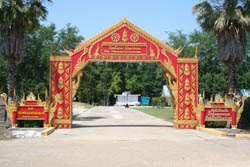
Lanexang's temple's name is Wat Thammarattanaram. "Wat" is the Laotian word for temple, and "Thammarattanaram" refers to the chanting the monks perform. Laotians founded the temple, but it also serves the spiritual needs for Thai and Cambodian residents in the Lafayette and New Iberia area. In front of the temple is the small, three-street community that comprises Lanexang Village. The houses are Western in style and aside from the street names--Lungprabang Street, Suvanaket Street, Vientia Street, cities and provinces in Laos--and the residents' shoes neatly placed by their front doors, one could not distinguish it from any other local neighborhood. At the back of the community, however, the Laotian presence becomes abundantly apparent. A brick wall runs roughly a hundred yards in front of the temple's grounds, demarcating the temple from the village, and on top of the brick columns is the same teardrop design that can be seen on a Therevadan Buddhist cremation urn.
The festival commenced around 10 a.m. on Friday on the temple grounds with an offering ceremony received by monks. The ceremony ends in early afternoon, at which time people return to their homes, most of which are walking distance from the temple. Later in the afternoon, they return to the temple's covered, open-air building that serves as a dance floor and stage for the Miss Sankhara pageant, a beauty pageant for high school girls.
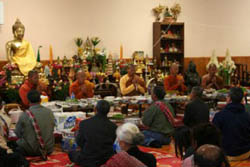
Photo: Maida Owens.
On Saturday morning, people begin arriving at the temple around 7 a.m.; many bring offerings of household goods for the monks. After the ceremony, traditional Laotian food is served to the monks and then the lay persons. At 1 p.m., a small parade winds its way through the village's three streets before entering the temple grounds, where the revelry continues well into the morning. Sunday's activities start closer to noon, and the day is spent in more leisurely shopping and eating at outdoor shops set up on the temple grounds.
Laos lies at the crossroads of the Asian continent, assimilating aspects of Indian and Sino/Chinese cultures. The mythic story behind Songkran embodies this point. This Hindu myth came to Laos from India. When Hinduism arrived, the indigenous people already practiced animism. Later, when most Laotians adopted Therevadan Buddhism, they did not dispel the Hindu or animistic beliefs and imagery in their myths. Now, early in the 21st century, Lanexang Village is adapting the festival to fit their lives in America. For example, according to the 2007 lunar calendar used in Laos, Songkran fell on April 13, 14, and 15. Lanexang community leaders changed the date of their festival to coincide with Easter, thereby giving the community members a long weekend in which to enjoy New Years. Despite the fact that Songkran at Lanexang's temple is not held on the traditional three days, according to community leaders their Songkran festival is the largest Laotian festival of any kind held in the United States and the only Laotian Songkran festival in the United States. Mr. Somvang Somemangkshala, one of the festival's planners, says that each year approximately "3 or 4000 people attend, and not all are members of the local community. Laotians come from Houston, Dallas, Mississippi, Tennessee, Alabama, Washington, D.C., and California. Sometimes friends and family who have been separated since immigrating to America find each other at the festival."
Like all groups who have immigrated to America, Laotians have brought their foodways with them, and Songkran is a time to enjoy traditional cuisine. On the temple grounds, booths are set up where people cook and serve food. They sell somtam (papaya salad with small crabs, tomatoes, dried shrimp, fish sauce, and sugar), plara (ground fish that is very salty), guaytial (noodle soup with meatballs of either beef or pork), and koatom (rice soup made with pork, chicken, or seafood). Laotian merchants from other states attend the Songkran festival to sell wares such as small mango trees and kaffir-lime plants, the leaves of which are used as a flavoring in curry dishes. These dishes, fruits, and vegetables are central to the traditional Laotian and Thai diet--there is much overlap in the two nations' cuisines--and are difficult to find outside of meals in Laotian homes or at the temple after a ceremony. The food served in the temple in the morning is delicious and consists of a wider variety of dishes. There is, for instance, a dessert called tao-suan, made of green beans, sugar, coconut milk, water, salt, and potato flour. Tao-suan is very sweet with a taste and consistency of rice pudding. Outside the temple, food vendors, who are mainly Lanexang residents, offer choices ranging from grilled chicken to noodle soup. The most ubiquitous dish offered is kao-larm--sticky rice with black beans grilled inside of bamboo. While tao-suan is a common dessert that is cooked on regular occasions, kao-larm is a traditional Laotian holiday food.
Friday
At the 2007 celebration, women's dress for the offering ceremonies on Friday and Saturday mornings was mainly traditional, which means a silk skirt and top. The men mainly wore western-style clothes--jeans or slacks--but at the offering ceremony most of the men wear a traditional sash of silk over their shirts. The sash is removed after the offering ceremonies. At Friday night's dance the men wore western-style clothes, mainly suits for the older men and slacks or jeans for the younger men and teenagers. The middle-aged and older women wore traditional Laotian silk wrap-around skirts and blouses that are usually short-sleeve and match the color and pattern of the skirt. Or they wear contemporary dresses in the traditional style. The younger women and teenagers mainly wore western dresses, slacks, or jeans.
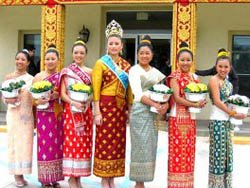
One group of young women wearing traditional dresses were the contestants of the Miss Sankhara pageant at the dance Friday night. The Friday night dance began at approximately at 8 p.m. and went on until 2 a.m. In the past, the dance was held in New Iberia at a community center in the city's park, but now the Lanexang villagers have built a covered stage and dance floor on the temple's grounds. At 10:30 pm Friday night, the contestants emerged one by one from back of the stage dressed in bright silk dresses. There were seven contestants, all high school students from the various Laotian communities represented at the festival, who lined up across the front of the stage. At 11:15 p.m. the contestants returned in western evening gowns, and as they came out, they stopped at the microphone and gave information about themselves in Laotian, then again lined up. After this portion of the pageant, the politicking began, as friends and family members of the contestants tried to convince those around them for whom they should vote. On the bottom of the dance tickets were the numbers one through seven, each corresponding to the contestants, and people circled the number of the contestant they liked the best. Once that was done, people took their tickets to a large table that sat on the edge of the dance floor, and placed the tickets in a ballot box that was covered in festive paper and a large purple bow. The voting was a gradual process; people cast their choices into the box slowly over the next two hours. After hours of politicking by some revelers for their favorite contestant, the contestant from Texas was elected the winner.
Saturday
On Saturday morning, people began arriving at the temple as early as 8 a.m., and around 10 a.m., the second of the festival's offering ceremonies is held. This offering ceremony has many people, but less than Friday morning's ceremony and for this reason Saturday morning's ceremony is held inside the temple. Once the ceremony is finished, the monks are given the food that has been cooked by members of the community. The monks are fed first because they are not allowed to eat after noon. Once the monks have finished, more food is brought out on low tables and people begin gathering and enjoying a traditional Laotian lunch of sticky rice (the staple of Laotian cuisine) and numerous combinations of meats and vegetables, many of which may be too spicy for the average American palate. However, there are other dishes served such as grilled chicken, which is not spicy.
After people finished lunch inside the temple, they made their way outside and took up positions along the parade route that meanders through the village's three streets. The parade began on Lungprabang Street (facing the temple, this is the street on the right), and then made its way to the street on the on the right, which is Suvanaket Street. From there it momentarily left the village's streets and made its way on to Melancon Road in order to turn and come down the center of the community on Vientia Street, which leads straight to the temple.
In 2007, Saturday was cloudy, windy, and cold. As the parade commenced a little after 1 p.m., so did sleet, tat-tat-tatting heads, caps, and umbrellas. In 2003, the parade had only three floats, but this year it had seven floats. Despite the small number of floats, this was no subdued affair, for every one in attendance was raucous. The first float in the 2007 parade (and in every year's parade) carried three golden statues of Buddha; on the second float sat the Nang-Songkran pageant contestants. Over their ornate and brightly-colored traditional dresses they wore yellow sports jackets and held bamboo umbrellas due to the wet weather. The third float was Lanexang Village's; the revelers wore bright red t-shirts announcing the year (2550) as the year of the Boar. The truck had speakers mounted in its bed and it played a Laotian song (melodic and bluesy) to which women in traditional dress (also bright red and trimmed in black) danced. Behind them were the revelers. Beers and bottles of cognac in hand, they exhorted, cheered, mimicked, and all around had a playful time as the parade progressed. The revelers' big moment, along with that of the traditional dancers, occurred a few feet before they entered the temple grounds. They stopped on the street and danced for judges consisting of Laotian leaders and political figures in Iberia Parish. The traditional dance troop performed a choreographed dance for the judges, and behind them were most of the members of Lanexang Village having a high time. This continued with four other floats consisting of Laotians from other states.
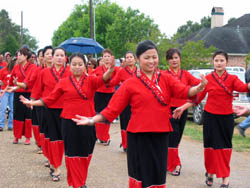
Throwing water is the most well known aspect of Songkran--many westerners who have witnessed Songkran festivities in Laos simply call it the Water Festival. In Laos, the water-play is ubiquitous--everyone participates throughout the festival, but at Lanexang, the water-play is for the children, who use water guns to drench each other. While the water-play may seem to be simply a fun activity, it has a deeper symbolic meaning. In Laotian culture, water is the symbol of life for, without water, the main crop of rice could not grow and sustain the people. Therefore, unlike western cultures in which the sun is often seen as the most powerful force of nature, in Southeast Asia water holds the prominent rank. On a practical point, in Laos Songkran falls during the hottest season of the year, and drenching others with water, which is often chilled with ice, gives all a cooling break from the tropical heat. From the spiritual aspect, water is a purifier, washing away bad luck, sins, and infirmities.
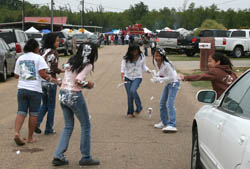
While the water-play at Lanexang is not as pervasive as it is in Laos, the water here, just as in Laos, is scented with perfume, so that the water not only cools one but also contains a good smell that is symbolic of good tidings for the coming year. In addition to water-play, it is customary in Laos to make a white powder with curcuma, an herb in the ginger family that is used in many important Laotian and Thai ceremonies such as weddings. The white powder is rubbed gently on peoples' faces and is intended to bring good luck for them in the new year. In place of the powder, however, Lanexang vendors sell extra large bottles of shaving cream. Instead of rubbing powder on others' faces, the children, when they are not soaking each other with water, spray shaving cream on each other. Lanexang's residents, consciously or not, have altered Songkran's traditional acts of throwing water and rubbing white powder on others' faces, and these acts have become the domain of the children.
There are two temples on the grounds; the original one is a brick building, soft gray in color that resembles a ranch-style house. The only distinguishing feature is the powder-blue metal roof that has the peaks and pointed corners in the Southeast Asian style. The new temple sits closer to the street; the roof is four-stories high, and with the stylistic peaks, it makes for an impressive structure. Over the doorway is a sparkling painting of the Buddha sitting with some of his orange-robed disciples.
After the parade, the trucks that had pulled the parade floats parked on the temple grounds and continued blasting music, while people danced around their floats and under the covered dance floor where the Friday night dance was held. On the grounds near the old temple were vendors' tents that sold food, Laotian and Thai CDs and DVDs, as well as traditional and non-traditional clothes. The food vendors were members of the local Laotian community, but the clothing and music vendors came from Texas, Georgia, and Illinois. Cajun and American influences on the festival were found at the tent nearest the ground's entranceway. While the majority of the food vendors sold only Laotian food--the most common being papaya salad and barbecued chicken--this tent offered Cajun fare: crawfish boudin and cracklins.
One of the clothing tents specialized in t-shirts and, taking a cue from the "Got Milk?" advertising campaign, they offered shirts that begged the questions: "Got Rice?" and "Got Sticky Rice?" Rice, of course, is the staple of Laotian food, and sticky rice is a traditional Laotian delicacy. Here we see the merging of traditional foodways with American marketing strategies, and the newest t-shirt at this year's festival combined Laos [and] Louisiana to proclaim: "Lao-weezeeana."
Sunday
Sunday was the final day of the festival, and people began arriving at Wat Thammarattanaram late in the morning. Around 4 or 5 p.m., those who wanted to help build the chedi, which traditionally was often a sand sculpture. There was not a strict schedule kept, so if people were having fun eating and mingling, the chedi was built later in the evening. Once it was built on the temple grounds, the monk leads the people in prayer around the sand sculpture. Chedis in Laos can be ornate structures, but this year in Lanexang the chedi was simply a mound of dirt that was decorated, primarily by older women and small children, with brightly colored flags. Traditionally, the chedi served a practical purpose of replenishing the dirt around a temple, because throughout the year the traffic of visitors to a temple would cause the ground around the temple to lower, so after the chedi was blessed, the sculpture was destroyed and its dirt spread around a temple. Lanexang's original temple has concrete and asphalt parking lot on two sides and the newer temple has a concrete and asphalt parking in front of it, hence there is no need for distributing dirt at their bases. The building of Lanexang's chedi was a traditional symbolic act.
After the chedi was decorated and blessed, usually around 6 p.m., the people who brought birds to release gathered and a monk led the people in prayer and then threw the birds into the air. This final merit-making act to improve one's karma signaled the end of the festival.
Conclusion
Songkran has its roots in Hinduism and Buddhism, and for Lanexang Village of Iberia Parish the festival is a way of maintaining Laotian culture in their new country, as well as a way to invite non-Laotians to their community. Lanexang Village's Songkran celebration can be broken into constants and variants. The constants are the traditional clothing, traditional food, traditional music, traditional dance, language, the spirituality and rituals. The variants are the days the festival is held, shaving cream replacing the white powder, the water play being less frenetic and confined to children's activities, the selling of Cajun boudin and cracklins, the t-shirts asking "Got Rice?" and proclaiming that this area, at least for this weekend, is Lao-weezeeana. The members of the greater Lanexang Laotian community are doing an excellent job of preserving their culture, while at the same time not turning their backs on American culture. They are neither stifled by their older culture, nor are they overrun by their new culture.


